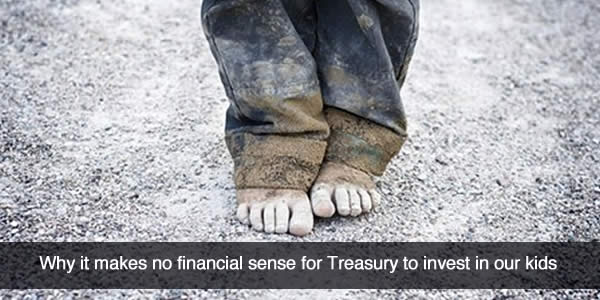Today UNICEF released its report on child wellbeing. They found that during the global financial crisis New Zealand’s level of child poverty didn’t budge. Child poverty rose in most countries, thanks to the financial crisis, and fell in a few. This mediocre result for New Zealand has prompted calls for more action in this area. But actually, the way we run our books makes investing in kids a hard sell to the bean counters in Treasury. This blog looks at why.
What did the UNICEF report actually find?
The UNICEF report looked at 41 countries in the European Union and other developed economies around the world. In 23 of those countries, child poverty rose between 2008-2012. This should be no surprise given the global financial crisis, which hit many developed economies far harder than it hit us here in New Zealand. Thank goodness for exporting milk powder to China!
In other countries child poverty has dropped, particularly in Australia, Poland, and Chile. The Government has responded that it is unfair to compare us to Aussie, because thanks to their mining boom they weren’t in a recession at the time. Critics are pointing out that Government should be spending more in this area if they are serious about tackling the problem.
Money is only part of the answer
We have written extensively on our position on welfare – the unconditional basic income. Everyone would receive an income of $11,000 per year, no questions asked. This wouldn’t increase benefits, but would ensure that people don’t lose their benefits when they move into work. It would provide a strong incentive to work and would hugely benefit the working poor. This concept could be extended into an unconditional payment to children also.
However, let’s not kid ourselves that money is the complete answer to child poverty. Throwing money at the problem may have helped in Australia, but it will never take care of issues of dysfunctional families caught in a vicious cycle. Or at least, if we simply throw money at the problem, at some point we would risk removing all incentive to work and invest in education.
What else is needed?
The short answer is that we don’t really know for sure. Breaking the cycle is incredibly difficult, and takes a lot of investment at an early age. Some great work was done on child health by the Health Select Committee last term of Parliament. One of the most promising interventions in this area was of the Early Start programme run by the Ministry of Social Development. Yet it hasn’t been followed up with the investment needed.
The problem is that it can take a long time to know if that investment is worthwhile! Basically we have to wait till a child grows up – maybe 15 years to see the education benefits, 20 to see any reductions in crime, sometimes up to 40 years to see improvements in lifetime health.
This is a real problem, because the way we do politics and financial calculations is not cut out for these sorts of payback periods. Politics as we all know operates on 3 year cycles. As we saw in Health Cheque, our review of the health system, this short term focus leads politicians to focus on making sure that middle class grannies get their hip and knee operations now, rather than investing in reducing future health problems amongst our neediest children.
But another problem, one that isn’t talked about, is the power of financial calculations.
The power of the discount rate
When we work out whether to invest in something, it is standard financial practice to discount things that happen in the future. You are probably thinking what the hell? But I bet you do it too. I’ll explain.
A dollar today is worth more than a dollar next year. You’d much rather have a dollar today than next year right? How much would I have to pay you in a year to make you happy to wait for that time? A dollar and ten cents? A dollar fifty? Two dollars? More? That is your discount rate.
Businesses and the public sector do the same thing when they make an investment. If they are investing a million dollars now, they expect more than a million dollars in the future to make the investment worthwhile. The more distant the benefits are, the harder it becomes to make the investment worthwhile.
So to invest in a programme that makes kids better off in 30 years time, once you apply a discount rate those benefits need to be huge. At least, that is the case given the discount rates used in the public sector – which can sometimes be close to 10%. That sort of discount rate means that we need more than two and a half times the benefit in ten years time than what we spent in the first place.
This is a big area of debate in economics and finance. What discount rate should we use when it comes to our kids or our environment? Some argue that we shouldn’t have a discount rate at all – that a dollar of benefit to our kids or the environment tomorrow should be worth the same as a dollar today. The retort is that for generations the world has been getting richer – so why not acknowledge that the young of tomorrow will be richer than we are today? Then the environmentalists respond that the world’s limited resources mean that the young of today will not be better off tomorrow.
And so the argument goes on. There are no easy answers, but the issues matter an awful lot. You might think the discount rate used by the government is too high. But then you probably use a higher discount rate in your own life.

